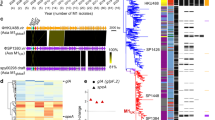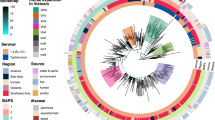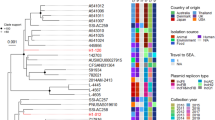Abstract
A scarlet fever outbreak began in mainland China and Hong Kong in 2011 (refs. 1–6). Macrolide- and tetracycline-resistant Streptococcus pyogenes emm12 isolates represent the majority of clinical cases. Recently, we identified two mobile genetic elements that were closely associated with emm12 outbreak isolates: the integrative and conjugative element ICE-emm12, encoding genes for tetracycline and macrolide resistance, and prophage ΦHKU.vir, encoding the superantigens SSA and SpeC, as well as the DNase Spd1 (ref. 4). Here we sequenced the genomes of 141 emm12 isolates, including 132 isolated in Hong Kong between 2005 and 2011. We found that the introduction of several ICE-emm12 variants, ΦHKU.vir and a new prophage, ΦHKU.ssa, occurred in three distinct emm12 lineages late in the twentieth century. Acquisition of ssa and transposable elements encoding multidrug resistance genes triggered the expansion of scarlet fever–associated emm12 lineages in Hong Kong. The occurrence of multidrug-resistant ssa-harboring scarlet fever strains should prompt heightened surveillance within China and abroad for the dissemination of these mobile genetic elements.
This is a preview of subscription content, access via your institution
Access options
Subscribe to this journal
Receive 12 print issues and online access
$209.00 per year
only $17.42 per issue
Buy this article
- Purchase on Springer Link
- Instant access to full article PDF
Prices may be subject to local taxes which are calculated during checkout

Similar content being viewed by others
References
Chen, M. et al. Outbreak of scarlet fever associated with emm12 type group A Streptococcus in 2011 in Shanghai, China. Pediatr. Infect. Dis. J. 31, e158–e162 (2012).
Hsieh, Y.C. & Huang, Y.C. Scarlet fever outbreak in Hong Kong, 2011. J. Microbiol. Immunol. Infect. 44, 409–411 (2011).
Lau, E.H., Nishiura, H., Cowling, B.J., Ip, D.K. & Wu, J.T. Scarlet fever outbreak, Hong Kong, 2011. Emerg. Infect. Dis. 18, 1700–1702 (2012).
Tse, H. et al. Molecular characterization of the 2011 Hong Kong scarlet fever outbreak. J. Infect. Dis. 206, 341–351 (2012).
Wong, S.S.Y. & Yuen, K.Y. Streptococcus pyogenes and re-emergence of scarlet fever as a public health problem. Emerging Microbes Infections 1, e2 (2012).
Yang, P. et al. Characteristics of group A Streptococcus strains circulating during scarlet fever epidemic, Beijing, China, 2011. Emerg. Infect. Dis. 19, 909–915 (2013).
Walker, M.J. et al. Disease manifestations and pathogenic mechanisms of group A Streptococcus. Clin. Microbiol. Rev. 27, 264–301 (2014).
Duncan, S.R., Scott, S. & Duncan, C.J. Modelling the dynamics of scarlet fever epidemics in the 19th century. Eur. J. Epidemiol. 16, 619–626 (2000).
Katz, A.R. & Morens, D.M. Severe streptococcal infections in historical perspective. Clin. Infect. Dis. 14, 298–307 (1992).
Su, Y.F. et al. Changing epidemiology of Streptococcus pyogenes emm types and associated invasive and noninvasive infections in Southern Taiwan. J. Clin. Microbiol. 47, 2658–2661 (2009).
Liang, Y. et al. Epidemiological and molecular characteristics of clinical isolates of Streptococcus pyogenes collected between 2005 and 2008 from Chinese children. J. Med. Microbiol. 61, 975–983 (2012).
Jing, H.B. et al. Epidemiological analysis of group A streptococci recovered from patients in China. J. Med. Microbiol. 55, 1101–1107 (2006).
Beres, S.B. et al. Molecular genetic anatomy of inter- and intraserotype variation in the human bacterial pathogen group A Streptococcus. Proc. Natl. Acad. Sci. USA 103, 7059–7064 (2006).
You, Y. et al. Draft genome sequences of two Streptococcus pyogenes strains involved in abnormal sharp raised scarlet fever in China, 2011. J. Bacteriol. 194, 5983–5984 (2012).
Croucher, N.J. et al. Rapid pneumococcal evolution in response to clinical interventions. Science 331, 430–434 (2011).
Drummond, A.J. & Rambaut, A. BEAST: Bayesian evolutionary analysis by sampling trees. BMC Evol. Biol. 7, 214 (2007).
Beres, S.B. et al. Molecular complexity of successive bacterial epidemics deconvoluted by comparative pathogenomics. Proc. Natl. Acad. Sci. USA 107, 4371–4376 (2010).
Silva-Costa, C., Carriço, J.A., Ramirez, M. & Melo-Cristino, J. Scarlet fever is caused by a limited number of Streptococcus pyogenes lineages and is associated with the exotoxin genes ssa, speA and speC. Pediatr. Infect. Dis. J. 33, 306–310 (2014).
Banks, D.J., Beres, S.B. & Musser, J.M. The fundamental contribution of phages to GAS evolution, genome diversification and strain emergence. Trends Microbiol. 10, 515–521 (2002).
Harris, S.R. et al. Evolution of MRSA during hospital transmission and intercontinental spread. Science 327, 469–474 (2010).
He, M. et al. Emergence and global spread of epidemic healthcare-associated Clostridium difficile. Nat. Genet. 45, 109–113 (2013).
Stamatakis, A. RAxML-VI-HPC: maximum likelihood–based phylogenetic analyses with thousands of taxa and mixed models. Bioinformatics 22, 2688–2690 (2006).
Drummond, A.J., Suchard, M.A., Xie, D. & Rambaut, A. Bayesian phylogenetics with BEAUti and the BEAST 1.7. Mol. Biol. Evol. 29, 1969–1973 (2012).
Lemey, P., Rambaut, A., Drummond, A.J. & Suchard, M.A. Bayesian phylogeography finds its roots. PLoS Comput. Biol. 5, e1000520 (2009).
Zerbino, D.R. & Birney, E. Velvet: algorithms for de novo short read assembly using de Bruijn graphs. Genome Res. 18, 821–829 (2008).
Carver, T.J. et al. ACT: the Artemis Comparison Tool. Bioinformatics 21, 3422–3423 (2005).
Zhou, Y., Liang, Y., Lynch, K.H., Dennis, J.J. & Wishart, D.S. PHAST: a fast phage search tool. Nucleic Acids Res. 39, W347–W352 (2011).
Alikhan, N.F., Petty, N.K., Ben Zakour, N.L. & Beatson, S.A. BLAST Ring Image Generator (BRIG): simple prokaryote genome comparisons. BMC Genomics 12, 402 (2011).
Hyatt, D. et al. Prodigal: prokaryotic gene recognition and translation initiation site identification. BMC Bioinformatics 11, 119 (2010).
Seemann, T. Prokka: rapid prokaryotic genome annotation. Bioinformatics 30, 2068–2069 (2014).
Wong, S.S., Ho, P.L., Woo, P.C. & Yuen, K.Y. Bacteremia caused by staphylococci with inducible vancomycin heteroresistance. Clin. Infect. Dis. 29, 760–767 (1999).
Cole, J.N. et al. Role of group A Streptococcus HtrA in the maturation of SpeB protease. Proteomics 7, 4488–4498 (2007).
van de Rijn, I. & Kessler, R.E. Growth characteristics of group A streptococci in a new chemically defined medium. Infect. Immun. 27, 444–448 (1980).
Barnett, T.C. et al. The globally disseminated M1T1 clone of group A Streptococcus evades autophagy for intracellular replication. Cell Host Microbe 14, 675–682 (2013).
Acknowledgements
We thank the core sequencing and pathogen informatics teams at the Sanger Institute for their assistance. This work was supported by National Health and Medical Research Council of Australia (NHMRC) program grant 565526, Australian Research Council grant DP140102881, a Research Fund for the Control of Infectious Diseases Commissioned Grant from the Hong Kong government and Wellcome Trust grant 098051. M.R.D. is supported by an NHMRC postdoctoral training fellowship (635250). M.J.W. is supported by an NHMRC principal research fellowship (631386).
Author information
Authors and Affiliations
Contributions
M.R.D., K.-Y.Y., G.D. and M.J.W. were involved in the study design. K.-Y.Y., H.T. and J.H.K.C. provided the assessment of clinical cases and the bacterial samples. M.R.D., M.T.H., P.C., J.H.K.C., C.V., T.C.B. and N.L.B.Z. performed the analyses. M.R.D., P.C. and M.J.W. wrote the manuscript. All authors read and approved the manuscript.
Corresponding author
Ethics declarations
Competing interests
The authors declare no competing financial interests.
Integrated supplementary information
Supplementary Figure 1 Annual incidence of scarlet fever.
Reported cases of scarlet fever in Hong Kong (a) and mainland China (b) as reported by the Centre for Health Protection, Department of Health, Government of the Hong Kong Special Administrative Region and by the Ministry of Health, the National Health and Family Planning Commission of the People’s Republic of China.
Supplementary Figure 2 Identification of recombined genomic regions on the basis of GAS emm12 whole-genome alignment.
The maximum-likelihood phylogeny excluding recombined regions is represented on the left of the figure, and the four major clades are indicated. The HKU16 reference genome is represented above the position of recombined ‘blocks’ for each taxon in the tree. Recombination events common to multiple related taxa (through common descent) are indicated by a red block or by a blue block, if unique to a single terminal taxon. Recombination is largely limited to the locations of mobile genetic elements, implying high stability within the core emm12 genome. SNPs located within the boundaries of the mobile elements were excluded.
Supplementary Figure 5 Characterization and temporal distribution of the novel ssa-carrying prophage elements ΦHKU.ssa, ΦHKU165.4 and ΦHKU.vir within the emm12 population.
Coding sequences referring to the prophage-associated virulence genes speC (purple), spd1 (yellow), spd3 (dark brown) and ssa (pink) are indicated. (a) Representation of ΦHKU.ssa (light brown; 42.9 kb) from strain HKU360 and ΦHKU165.4 (black; 46.0 kb) from strain HKU165. The scale bar is shown in kilobase pairs. (b) BLASTN comparison of ΦHKU.ssa with the prophage sequences ΦMGAS9429.1 and ΦMGAS10750.3. ΦHKU.ssa is a chimeric element of both of these elements and is located at the ΦMGAS10750.3 att site. Red blocks indicate homologous sections of genome sequence as defined by BLASTN. (c) BLASTN comparison of ΦHKU165.4 with the prophage sequences ΦHKU.vir and ΦNZ131. All three prophage elements share the same attachment site but carry different virulence determinants. Red blocks indicate homologous sections of genome sequence as defined by BLASTN. (d) Bayesian phylogeny of the emm12 population with the distribution of ΦHKU.ssa (light brown), ΦHKU165.4 (black) and ΦHKU.vir (blue) indicated on the right. Color-coded branches indicate clones possessing ΦHKU.ssa, ΦHKU165.4 and ΦHKU.vir, and arrows indicate predicted insertion dates within the emm12 population.
Supplementary Figure 6 Comparative analysis and temporal distribution of speC- and spd1-harboring phage variants within the GAS emm12 population.
ΦSF370.1 (black) from the M1 GAS strain SF370 is a closely related variant of ΦNS488.1 and is represented at the top of the figure. Another five major variants are present within the emm12 population. The yellow and purple coding sequences refer to the deoxyribonuclease spd1 and the streptococcal pyrogenic exotoxin speC, respectively. Red blocks indicate homologous sections of genome sequence as defined by BLASTN. The different prophage variants are color coded, and their distribution relative to the emm12 Bayesian phylogeny is indicated to the left of the figure. An asterisk indicates that ΦHKU43.1 and ΦHKU81.4 are partial genome sequences, with the location of the assembly break indicated by a gray box. With the exception of ΦHKU81.4, which is located at the ΦHKU.vir attachment site, all represented prophages are located at the same genomic location as ΦSF370.1 (ΦMGAS9429.1).
Supplementary Figure 7 Comparative analysis and temporal distribution of antibiotic resistance integrative and conjugative elements (ICEs) within the GAS emm12 population.
(a) Comparative genomics of eight ICE variants identified within the GAS emm12 population. Tetracycline (tetM and tetO) and macrolodide (ermB and ermTR) resistance coding sequences are indicated in blue, yellow, purple and brown, respectively. Red blocks indicate homologous sections of genome sequence as defined by BLASTN. Each variant is color coded, and distributions relative to the emm12 Bayesian phylogeny are indicated in b. Presence (black box) and absence (white block) of tetM, tetO, ermB and ermTR are indicated. Color-coded branches indicate clones possessing ICE variants, and arrows indicate predicted insertion times within the emm12 population.
Supplementary information
Supplementary Text and Figures
Supplementary Figures 1–7. (PDF 1780 kb)
Supplementary Table 1
Details of S. pyogenes M12 strains used in this study and associated distribution of toxin and antibiotic resistance genes. (XLSX 65 kb)
Rights and permissions
About this article
Cite this article
Davies, M., Holden, M., Coupland, P. et al. Emergence of scarlet fever Streptococcus pyogenes emm12 clones in Hong Kong is associated with toxin acquisition and multidrug resistance. Nat Genet 47, 84–87 (2015). https://doi.org/10.1038/ng.3147
Received:
Accepted:
Published:
Issue Date:
DOI: https://doi.org/10.1038/ng.3147
This article is cited by
-
Pathogenesis, epidemiology and control of Group A Streptococcus infection
Nature Reviews Microbiology (2023)
-
Detection of Streptococcus pyogenes M1UK in Australia and characterization of the mutation driving enhanced expression of superantigen SpeA
Nature Communications (2023)
-
SweepCluster: A SNP clustering tool for detecting gene-specific sweeps in prokaryotes
BMC Bioinformatics (2022)
-
Prophage exotoxins enhance colonization fitness in epidemic scarlet fever-causing Streptococcus pyogenes
Nature Communications (2020)
-
Increasing incidence of group B streptococcus neonatal infections in the Netherlands is associated with clonal expansion of CC17 and CC23
Scientific Reports (2020)



